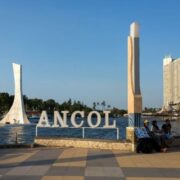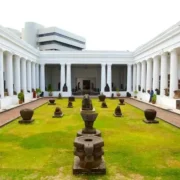Explore Jakarta International Stadium: A Modern Sports and Entertainment Icon
The Jakarta International Stadium (JIS) is one of the most modern and iconic sports and entertainment venues in Indonesia, located in the heart of Jakarta. As the largest stadium in the country, it has become a symbol of Indonesia’s commitment to improving its sports infrastructure and hosting international events. The stadium, with its futuristic design and state-of-the-art facilities, is capable of hosting a variety of major sporting events, concerts, and cultural performances, attracting not only sports fans but also entertainment enthusiasts from around the world.
JIS plays a significant role in Jakarta’s sports and entertainment landscape, offering a world-class experience for both local and international audiences. As Jakarta sports venues continue to evolve, the stadium in Jakarta has set a new standard in terms of design, technology, and capacity. This ambitious project is aimed at elevating Jakarta’s position on the global sports map and enhancing the city’s tourism and entertainment offerings. With its cutting-edge sports infrastructure, JIS is expected to become the primary venue for large-scale sporting events, concerts, and various international performances, further solidifying Jakarta’s reputation as a vibrant and dynamic metropolitan city.
In summary, the Jakarta International Stadium is not just a stadium; it is a testament to Jakarta’s growing prominence in the global sports and entertainment scene. Whether you’re a sports fan or someone who enjoys large cultural events, JIS is a must-visit destination that promises an unforgettable experience.
Table of Contents
ToggleHistory and Construction of Jakarta International Stadium
The Jakarta International Stadium (JIS) stands as a monumental achievement in Indonesia’s sports infrastructure, marking a significant leap in the development of Jakarta’s urban landscape. The idea for JIS was conceived as part of a broader initiative to modernize Jakarta’s sports and entertainment venues to accommodate international-level events. Its construction began in 2019, intending to provide a state-of-the-art facility capable of hosting major sporting events, concerts, and other large-scale performances.
The construction of Jakarta International Stadium was a highly ambitious project, with a timeline stretching over several years. Despite challenges faced along the way, such as the COVID-19 pandemic and logistical hurdles, the stadium was designed to be a global symbol of modern sports infrastructure. The architectural design of JIS is nothing short of spectacular, featuring a fully retractable roof and cutting-edge technology, offering a unique and dynamic experience for attendees. The construction process was a major step in the city’s vision to create a lasting legacy of sports excellence and to elevate Jakarta’s position on the world stage as a major sports destination.
The Jakarta stadium history is closely intertwined with the city’s goal to enhance its sports tourism industry. This project serves as a key milestone in the city’s long-term development strategy to create top-tier venues that can cater to international audiences. The architectural design of JIS is a blend of modern and functional aesthetics, incorporating sustainable design principles while staying true to Jakarta’s identity. The stadium’s size, capacity, and features are a direct reflection of the sports development initiatives that have been growing in Indonesia, showing the country’s commitment to fostering athletic talent and hosting major global events in the future.
Overall, the construction of the Jakarta International Stadium has played a pivotal role in shaping Jakarta’s sports and entertainment future, positioning the city as a hub for international events while providing a first-class venue for both local and global audiences.
Features and Capacity of Jakarta International Stadium
The Jakarta International Stadium (JIS) is a cutting-edge sports venue that stands out not only for its size but also for the innovative design and technological features it incorporates. Designed with modern aesthetics and functionality in mind, the stadium blends advanced technology with user comfort to create an unparalleled experience for both athletes and spectators. One of the most striking features of JIS is its fully retractable roof, which ensures that the stadium can be used year-round, regardless of weather conditions. This feature also allows the stadium to host a wide range of events, from international football matches to large-scale concerts, without the disruption of rain or intense heat.
Design and Technological Advancements
Another notable JIS design element is its emphasis on sustainability. The stadium is equipped with environmentally friendly features, including energy-efficient lighting systems and water-saving technologies. The building’s structural integrity and safety have been prioritized, ensuring that the venue meets the highest global standards. The use of smart technology, such as advanced security systems, Wi-Fi accessibility, and interactive seating options, also contributes to the seamless experience for attendees, making it one of the most technologically advanced stadiums in the region.
Stadium Capacity and Layout
In terms of stadium capacity, JIS can seat up to 82,000 spectators, making it the largest stadium in Indonesia. The seating arrangement is designed to provide optimal sightlines and comfort for all viewers. The stadium’s layout incorporates various seating zones, from VIP areas to general seating, catering to a wide range of event-goers. Its design prioritizes accessibility, with easy access for individuals with disabilities and ample facilities such as restrooms, food and beverage stalls, and merchandise shops throughout the venue. This stadium seating arrangement ensures that every visitor can enjoy a premium experience, no matter where they sit.
With these features and its massive seating capacity, the Jakarta International Stadium is poised to become a key player in the world of international sports, offering a venue that can host a variety of events while delivering the highest standards in terms of comfort and technology.
The Economic Impact of Jakarta International Stadium
The Jakarta International Stadium (JIS) has become a key contributor to the local economy, offering numerous economic benefits to the city of Jakarta and Indonesia as a whole. As one of the largest and most technologically advanced sports venues in Southeast Asia, the stadium is an important catalyst for economic growth, especially in terms of tourism, hospitality, and the broader entertainment industry.
Contribution to Local Economy
The opening of Jakarta International Stadium has led to a significant economic boost in Jakarta’s local economy. The stadium attracts not only international sports events but also large-scale concerts, festivals, and entertainment performances. Each of these events brings in substantial revenue, not only for the stadium itself but also for local businesses, ranging from hotels to restaurants and transportation services. This influx of visitors creates a positive ripple effect throughout the economy, generating jobs and boosting spending in surrounding areas. Moreover, the development of JIS has improved infrastructure in the area, further promoting economic growth and urban renewal.
Tourism Development and Influx of Visitors
In addition to the economic benefits of large-scale events, the tourism development surrounding JIS has been substantial. Tourists visiting Jakarta for events at the stadium are likely to stay in hotels, eat at local restaurants, and explore other attractions in the city, contributing directly to Jakarta’s tourism economy. The increased visibility of Jakarta as an international sporting destination has helped to position the city as a hub for global tourism, drawing in visitors from abroad who may not have previously considered Jakarta as a must-visit destination. This tourism growth also encourages further investment in infrastructure and services, enhancing the overall visitor experience and stimulating economic development in multiple sectors.
Long-Term Economic Benefits
The long-term economic impact of the Jakarta International Stadium goes beyond immediate tourism and event revenue. The stadium is expected to play a major role in boosting Jakarta’s reputation as a global sports and entertainment destination, which could lead to continued growth in tourism and international investments. Additionally, the stadium’s role as a venue for various events will continue to attract large crowds, generating consistent economic activity and fostering a thriving entertainment ecosystem in Jakarta.
Overall, the Jakarta International Stadium serves as a powerful driver of economic activity, contributing to local businesses, expanding tourism, and creating a sustainable economic impact for the city and beyond.
How to Visit Jakarta International Stadium
The Jakarta International Stadium (JIS) is one of the city’s premier attractions, offering visitors a state-of-the-art sports and entertainment venue. If you’re planning a visit to JIS, whether for a sports event, concert, or guided tour, here’s everything you need to know about how to get there, along with helpful tips for an enjoyable visit.
Directions to Jakarta International Stadium
Jakarta International Stadium is located in the heart of the city, making it easily accessible from several areas of Jakarta. To get to the stadium, you can take various routes depending on your location. If you’re coming from central Jakarta, the easiest way is to use the Jakarta Inner Ring Road (Cakung) and head towards the stadium’s designated area.
For those unfamiliar with the area, GPS and maps apps can be a great help in providing turn-by-turn directions. The stadium is well-signposted, making it easy to spot as you get closer.
Public Transport Options
For Jakarta travel, public transport is one of the best ways to reach Jakarta International Stadium. The stadium is served by several modes of public transportation, including the TransJakarta Bus system and the Jakarta Metro (MRT). The nearest TransJakarta bus station is just a short walk away, and the closest MRT station offers another convenient option for visitors looking to avoid traffic.
In addition, you can also use ride-hailing services like Gojek or Grab, which offer a convenient and comfortable way to travel directly to the stadium. For those coming from out of town, taxis or shuttle services can also be arranged.
Parking at Jakarta International Stadium
For visitors who prefer to drive, JIS accessibility includes ample parking spaces. There are designated parking lots available for both cars and motorcycles, and the parking area is well-organized to accommodate large crowds during events. However, on event days, it is advisable to arrive early to secure a parking spot, as the demand can be high, especially during major sporting events or concerts.
Tips for Visitors
When visiting Jakarta International Stadium, it’s always a good idea to arrive early to avoid the rush and take the time to explore the stadium’s features. If you’re attending a game or concert, check in advance for any special entry requirements, such as security checks or bag restrictions. Visitors can also enjoy nearby attractions such as shopping malls, dining options, and cultural sites in the vicinity, making it a great day out for both sports enthusiasts and tourists.
For a more immersive experience, consider booking a stadium tour, where you can learn about the JIS’s history, design, and its impact on Jakarta’s sports scene. These tours offer unique insights into the stadium and its cultural significance.
Explore Jakarta’s Rich Heritage with Ekaputra’s Half-Day Tour
Having delved into the architectural marvels and cultural significance of the Jakarta International Stadium, it’s the perfect time to further immerse yourself in Jakarta’s rich history and vibrant culture. Ekaputra’s Jakarta Half-Day Tour offers a comprehensive exploration of the city’s most iconic landmarks, providing a deeper understanding of Jakarta’s heritage.
This curated Ekaputra tour includes visits to Merdeka Square, the National Monument, Istiqlal Mosque, Jakarta Cathedral, Old Town Batavia, a Puppet Studio, and Sunda Kelapa Harbor. Each stop is designed to offer insights into Jakarta’s diverse history and cultural tapestry. Whether you’re a history enthusiast or a cultural explorer, this tour promises an enriching experience. Embark on this journey to uncover the essence of Jakarta and create lasting memories.



